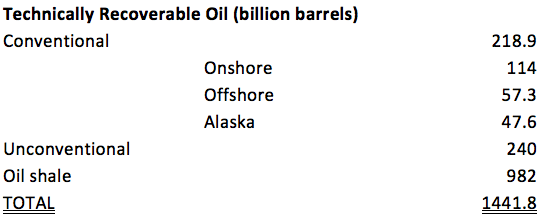According to data from the federal government and Rand Corporation, the United States has 1,442 billion barrels of technically recoverable oil.[i] These data are compiled, along with data about natural gas and coal resources in the Institute for Energy Research’s North American Energy Inventory.
Terminology
Technically recoverable oil resources are those oil resources that are producible using current technology without reference to current economic viability. In other words, technically recoverable oil is oil we can access using today’s technology.
In contrast to technically recoverable oil, proved or proven oil reserves are the estimated quantities that geological and engineering data demonstrate can be recovered from known reservoirs under existing economic and operating conditions. “Proved reserves” are a relatively small component of technically recoverable resources. According to the Energy Information Administration, the United States has 20.7 billion barrels of proved reserves.
Data Sources
IER’s North American Energy Inventory contains data obtained from Government or Government-funded sources. The sources include documents from the U.S. Department of Energy (Office of Fossil Energy), the Energy Information Administration, the National Energy Technology Laboratory and the U.S. Department of Interior (U.S. Geological Survey). The data are taken directly from the reports cited and are not altered for production that has occurred since the date of the information.
U.S. Technically Recoverable Oil
The table below breaks out the technically recoverable resources into 3 categories: conventional, unconventional, and oil shale. The conventional oil resources are broken out by location: onshore, offshore, and Alaska. They total 218.9 billion barrels and come from Table 9.1 of the Energy Information Administration report: Assumptions to the Annual Energy Outlook 2011.[ii] The unconventional portion of the technically recoverable oil resources total 240 billion barrels and come from a report developed by Advanced Resources International[iii] for the National Energy Technology Laboratory, U.S. Department of Energy.
The technically recoverable oil shale numbers total 982 billion barrels and are obtained from 2 sources: a study by the RAND Corporation that estimated that the technically recoverable oil shale resources to be 800 billion barrels[iv] and a U.S. Geological Survey study that estimated that there were an additional 500 billion barrels of in-place oil shale resources beyond what was included in the RAND study. Assuming the same rate of recovery for these additional 500 billion barrels of oil shale[v] brings the total recoverable resources to 982 billion barrels of oil resources. The United States uses roughly 7 billion barrels of oil per year.

To illustrate the conversion of technically recoverable resources to proven reserves, once can review the experience of the United States since 1944. Then, our proven oil reserves were 20 billion barrels, but since then, the United States has produced 175 billion barrels, and 20.7 barrels of proven reserves still remain today.Resources are converted from being technically recoverable to being proven reserves when investment (via exploration and development), access and economic viability work together to make them producible. Almost all oil production goes through this process, some recent notable examples being Canada’s oil sands, Brazilian offshore and the Bakken Field in North Dakota. In each case, huge increases in proven reserves occurred over very short periods of time.
[i] Institute for Energy Research, North American Energy Inventory, December 2011, http://energyforamerica.org/wp-content/uploads/2011/12/Energy-Inventory-FINAL.pdf
[ii] Energy Information Administration, Assumptions to the Annual Energy Outlook 2011, Table 9.1, http://www.eia.gov/forecasts/aeo/assumptions/pdf/oil_gas.pdf
[iii] U.S. Department of Energy, Office of Fossil Energy, Undeveloped Domestic Oil Resources: The Foundation for Increasing Oil Production and a Viable Domestic Oil Industry, February 2006, http://www.fossil.energy.gov/programs/oilgas/publications/eor_co2/Undeveloped_Oil_Document.pdf and http://www.fossil.energy.gov/programs/oilgas/publications/eor_co2/G_-_Updated_U_S__Oil_Resources_Table_2-1.pdf
[iv] RAND Corporation, Oil Shale Development in the United States, Prospects and Policy Issues, 2005, http://www.rand.org/content/dam/rand/pubs/monographs/2005/RAND_MG414.sum.pdf
[v] US Geological Survey, Oil Shale and Nahcolite Resources of the Piceance Basin, Colorado p. 1, Oct. 2010, http://pubs.usgs.gov/dds/dds-069/dds-069-y/ .



